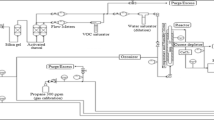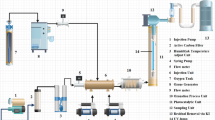Abstract
Photo-catalytic degradation of volatile organic compounds [VOCs: benzene, toluene and p-xylene (BTX)] was investigated using a batch reactor having a TiO2 (catalyst)-coated aluminum sheet and a source of UV light (sunlight or UV lamp). To study the photo-oxidation, experiments were conducted under the following configurations: (1) TiO2 (m): microparticle (0.32–3.31 µm) and sunlight (2) TiO2 (n): nanoparticle (0.80–4.70 nm) and sunlight, (3) TiO2 (m) and UV lamp and (4) TiO2 (n) and UV lamp. Degradation of BTX followed first-order decay for individual compounds. The degradation rate constant in min−1 cm−2 (coated surface area) was the highest for configuration (4) (benzene 1.07 × 10−3, toluene 1.36 × 10−3 and p-xylene 2.93 × 10−3) followed by configuration (2), thus indicating the importance of particle size of the catalyst in degradation. Degradation of BTX mixture did not follow first-order decay. Benzene was an intermediate product of oxidation of toluene. Benzene and toluene were intermediate products of oxidation of p-xylene. For degradation of BTX mixture, a mathematical model was proposed to predict concentrations as a function of time. Experimental and model results showed similar trends in BTX degradation. The model accounted for increases in mass of toluene and benzene due to the degradation of p-xylene.





Similar content being viewed by others
References
Ao CH, Lee SC, Mak CL, Chan LY (2003) Photo-degradation of volatile organic compounds (VOCs) and NO for indoor air purification using TiO2: promotion versus inhibition effect of NO. Appl Catal B Environ 42:119–129
Burstyn I, You X, Cherry N, Senthilselvan A (2007) Determinants of airborne benzene concentrations in rural areas of western Canada. Atmos Environ 41:7778–7787
Carp O, Huisman CL, Reller A (2004) Photoinduced reactivity of titanium dioxide. Prog Solid State Chem 32:33–177
Choi NC, Choi JW, Kim SB, Park SJ, Kim DJ (2009) Two-dimensional modelling of benzene transport and biodegradation in a laboratory-scale aquifer. Environ Technol 30:53–62
Collins AM (2012) Chemical techniques. In: Collins AM (ed) Nanotechnology cookbook, Elsevier, Amsterdam, pp 35–37. https://www.elsevier.com/books/nanotechnology-cookbook/collins/978-0-08-097172-8. Accessed 24 Feb 2015
Demeestere K, Dewulf J, De Witte B, Van Langenhove H (2007) Sample preparation for the analysis of VOCs in air and water matrices. J Chromatogr A 1153:130–144
Deshusses MA, Webster TS (2000) Construction and economics of a pilot/full-scale biological trickling filter reactor for the removal of volatile organic compounds from polluted air. J Air Waste Manag Assoc 50:1947–1956
Dhada I (2008) TiO2 based photo-catalytic oxidation of benzene, toluene and p-xylene. Master thesis, Indian Institute of Technology Kanpur, India
Dhada I, Sharma M, Gupta T, Agarwal S, Mohanan R (2012) TiO2-based photo catalytic oxidation of VOCs: coating to reactor performance and design. In: Proceedings of 6th international conference on environmental science and technology. American Academy of Sciences, Houston, p 43
Dutta C, Som D, Chatterjee A, Mukherjee AK, Jana TK, Sen S (2009) Mixing ratios of carbonyls and BTEX in ambient air of Kolkata, India and their associated health risk. Environ Monit Assess 148:97–107
Edgerton SA, Holdren MW, Smith DI, Shah J (1989) Inter urban comparison of ambient volatile organic compound concentration. JAPCA J Air Waste Manag 39:729–732
Everaert K, Baeyens J (2004) Catalytic combustion of volatile organic compounds. J Hazard Mater 109:113–139
Hager S, Bauer R (1999) Heterogeneous photocatalytic oxidation of organics for air purification by near UV irradiated titanium dioxide. Chemosphere 38:1549–1559
Hong I (2006) VOCs degradation performance of TiO2 aerogel photocatalyst prepared in SCF drying. J Ind Eng Chem 12:918–925
Hung JL (2001) Influence of temperature and humidity on the photo-catalytic decomposition of benzene. Graduate thesis China
Jacoby WA, Blake DM, Penned JA, Boulter JE, Vargo LM, George MC, Dolberg SK (1996) Heterogeneous photo catalysis for control of volatile organic compounds in indoor air. J Air Waste Manag Assoc 46:891–898
Jeong J, Sekiguchi K, Lee W, Sakamoto K (2005) Photodegradation of gaseous volatile organic compounds (VOCs) using TiO2 photoirradiated by an ozone-producing UV lamp: decomposition characteristics, identification of by-products and water-soluble organic intermediates. J Photochem Photobiol A 169:279–287
Jo WK, Park KH (2004) Heterogeneous photocatalysis of aromatic and chlorinated volatile organic compounds (VOCs) for non-occupational indoor air application. Chemosphere 57:555–565
Lau W-L, Chan L-Y (2003) Commuter exposure to aromatic VOCs in public transportation modes in Hong Kong. Sci Total Environ 308:143–155
Linsebigler AL, Lu G, Yates TJ (1995) Photocatalysis on TiO2 surfaces: principles, mechanisms, and selected results. Chem Rev 95:735–758
Lü H, Wen S, Feng Y, Wang X, Bi X, Sheng G, Fu J (2006) Indoor and outdoor carbonyl compounds and BTEX in the hospitals of Guangzhou, China. Sci Total Environ 368:574–584
Miller R, Fox R (1993) Treatment of organic contaminants in air by photo catalytic oxidation: a commercialization perspective, in photo catalytic purification and treatment of water and air. In: Proceedings of the 1st international conference on TiO2, pp 573–578
Mo J, Zhang Y, Xu Q, Lamson JJ, Zhao R (2009) Photocatalytic purification of volatile organic compounds in indoor air: a literature review. Atmos Environ 43:2229–2246
Obee TN (1996) Photooxidation of sub-parts-per-million toluene and formaldehyde levels on titania using a glass-plate reactor. Environ Sci Technol 30:3578–3584
Obee TN, Brown RT (1995) TiO2 photocatalysis for indoor air applications: effects of humidity and trace contaminant levels on the oxidation rates of formaldehyde, toluene, and 1,3-butadiene. Environ Sci Technol 29:1223–1231
Parish MV, Garcia RR, Bowen HK (1985) Dispersions of oxide powders in organic liquids. J Mater Sci 20:996–1008
Peral J, Ollis DF (1992) Heterogeneous photo catalytic oxidation of gas-phase organics for air purification: acetone, 1-butanol, butyaldehyde, formaldehyde, and m-xylene oxidation. J Catal 136:554–565
Puddu V, Choi H, Dionysiou DD, Puma GL (2010) TiO2 photocatalyst for indoor air remediation: influence of crystallinity, crystal phase, and UV radiation intensity on trichloroethylene degradation. Appl Catal B Environ 94(3–4):211–218
Rene ER, Murthy DVS, Swaminathan T (2005) Performance evaluation of a compost biofilter treating toluene vapours. Process Biochem 40(8):2771–2779
Seinfeld JH, Pandis SN (1997) Atmospheric chemistry and physics. Wiley, New York
Seisler Machine and Fabrication Corporation (2013) Custom machining and fabrication materials overview. http://www.seislermachine.com/index.html. Accessed 24 Feb 2015
Sharma M, Dhada I (2013) Development, Demonstration and pilot testing of nano-sized TiO2 based photo- catalytic oxidation technology for controlling VOCs: a collaborative effort of IIT Kanpur and Aarti Industries, Vapi. R&D Publication IIT Kanpur, Kanpur, pp 121–125. http://www.iitk.ac.in/directions/Directions_2013_01/article15.pdf
Sharma M, Dhada I, Behera S (2010) TiO2-based photocatalytic oxidation system for reduction of VOCs. Seminar on indoor air quality, Indo-French seminar, Indian Institute of Technology Delhi, India
Song Y, Shao M, Liu Y, Lu S, Kuster W, Goldan P, Xie S (2007) Source apportionment of ambient volatile organic compounds in Beijing. Environ Sci Technol 41(12):4348–4353
Srivastava A, Joseph AE, More A, Patil S (2005) Emissions of VOCs at urban petrol retail distribution centres in India (Delhi and Mumbai). Environ Monit Assess 109(1–3):227–242
Stevens L, Lanning JA, Anderson LG, Jacoby WA, Chornet N (1998) Investigation of the photocatalytic oxidation of low-level carbonyl compounds. J Air Waste Manag Assoc 48(6):979–984
Sun L, Li G, Wan S, An T (2010) Mechanistic study and mutagenicity assessment of intermediates in photo catalytic degradation of gaseous toluene. Chemosphere 78(3):313–318
United States Environmental Protection Agency (USEPA) (2006) The clean air act amendments of 1990. Washington. http://www.epa.gov/air/caa
Wang S, Ang HM, Tade MO (2007) Volatile organic compounds in indoor environment and photocatalytic oxidation: state of the art. Environ Int 33(5):694–705
You X, Senthilselvan A, Cherry NM, Kim HG, Burstyn I (2008) Determinants of airborne concentrations of volatile organic compounds in rural areas of Western Canada. J Expo Sci Environ Epidemiol 18(2):117–128
Zhang Y, Mu Y, Liu J, Mellouki A (2012) Levels, sources and health risks of carbonyls and BTEX in the ambient air of Beijing, China. J Environ Sci 24(1):124–130
Acknowledgments
We gratefully acknowledge the Glass Blowing Section of IIT Kanpur for making the reactor of desired shape and complexity. Services of Advance Center for Material Science (ACMS) and Nano-science Laboratory of IIT Kanpur for characterization of coating and ball milling of TiO2 to generate micro- and nano-sized particles are acknowledged. We are thankful to Professor Deepak Kunzru of Chemical Engineering for reading the research write-up and providing insight into the modeling.
Author information
Authors and Affiliations
Corresponding author
Rights and permissions
About this article
Cite this article
Dhada, I., Nagar, P.K. & Sharma, M. Photo-catalytic oxidation of individual and mixture of benzene, toluene and p-xylene. Int. J. Environ. Sci. Technol. 13, 39–46 (2016). https://doi.org/10.1007/s13762-015-0783-4
Received:
Revised:
Accepted:
Published:
Issue Date:
DOI: https://doi.org/10.1007/s13762-015-0783-4




